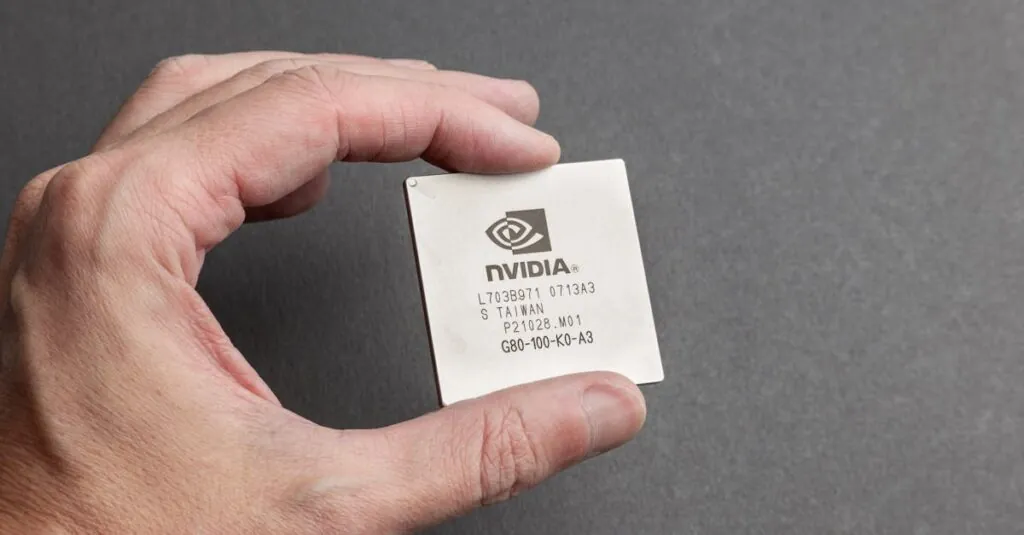In a world where speed and efficiency reign supreme, the neural processing unit (NPU) is the unsung hero of modern technology. Imagine a tiny brainiac working tirelessly behind the scenes, crunching data faster than a caffeine-fueled intern on a deadline. NPUs are designed to handle the heavy lifting of artificial intelligence tasks, making them essential for everything from self-driving cars to smart assistants that can actually understand your requests—yes, even the ones you mumble at 2 AM.
As demand for smarter devices skyrockets, understanding NPUs becomes crucial. They’re not just another tech buzzword; they’re the secret sauce that makes AI applications run smoother and faster. So, buckle up and prepare to dive into the fascinating world of neural processing units, where innovation meets efficiency in a delightful dance of silicon and circuits.
Table of Contents
ToggleOverview of Neural Processing Unit
A neural processing unit (NPU) accelerates artificial intelligence computations, optimizing performance in various applications. These specialized processors efficiently execute machine learning tasks, outperforming general-purpose CPUs and GPUs in specific scenarios.
Performance metrics illustrate the advantages of NPUs, particularly in deep learning applications. NPUs handle large volumes of data with robust parallel processing capabilities, enhancing speed and reducing latency. Their architecture, often tailored for matrix operations, further boosts their efficiency when processing neural networks.
Numerous industries benefit from NPU technology. Self-driving cars utilize NPUs for real-time data analysis, improving decision-making processes. Smart assistants rely on NPUs to enhance speech recognition and natural language processing, providing users with smoother interactions.
Energy efficiency matters significantly in NPU designs. Many NPUs consume less power than traditional processors while delivering superior performance, making them ideal for mobile devices and edge computing applications. This efficiency translates to longer battery life in smartphones and wearables.
Emerging trends in NPU development focus on increasing capabilities while maintaining energy efficiency. Future NPUs may integrate advanced features such as improved memory bandwidth and enhanced on-chip processing. These innovations aim to meet the growing demand for more intelligent devices that demand higher performance levels.
NPUs serve as critical enablers in the progression of AI technologies. Their role extends across various applications, highlighting their importance in shaping the future of smart devices and systems.
Architecture of Neural Processing Unit
The architecture of a neural processing unit centers around optimizing performance for AI tasks. It consists of specialized components designed to enhance efficiency and speed in computations.
Core Components
Core components of an NPU include processing cores, memory units, and interconnects. Processing cores, such as tensor cores, efficiently handle deep learning operations. Memory units leverage high bandwidth and low latency to store and access data rapidly. Interconnects facilitate communication among cores, significantly boosting overall performance. Each element collaborates to ensure the NPU excels in parallel processing and matrix operations, outperforming traditional CPUs and GPUs in specific tasks.
Data Flow Mechanisms
Data flow mechanisms in NPUs employ unique architectures to optimize information transfer. Streamlined pathways allow data to move quickly between cores and memory, reducing bottlenecks. Many NPUs utilize data locality principles, ensuring that frequently accessed data remains close to processing units. This method enhances throughput while minimizing energy consumption. Additionally, some designs incorporate dedicated data buses, improving the overall efficiency of data handling. Implementing these mechanisms propels NPUs ahead in the realm of AI performance.
Applications of Neural Processing Unit
NPUs find extensive use in various fields, enhancing the performance and efficiency of AI systems. Their specialized designs cater to different applications, driving innovation and improvement.
Machine Learning
NPUs excel in machine learning tasks by accelerating computations. These units handle large-scale data processing with ease, allowing for faster training of models. Optimized architectures support matrix operations that are central to many algorithms. Real-time data analysis benefits significantly from NPU capabilities. Additionally, developers leverage NPUs to improve inference times for applications such as recommendation systems and predictive analytics. The efficiency and performance of NPUs play a crucial role in refining these systems, making them more reliable and effective.
Computer Vision
Computer vision applications significantly benefit from NPUs. Efficient processing allows these units to analyze images and videos in real-time, essential for tasks like object detection and facial recognition. NPUs streamline the execution of convolutional neural networks, enhancing accuracy and reducing latency. With their parallel processing capabilities, NPUs enable faster image classification and segmentation. Additionally, cameras integrated with NPUs can process visual data locally, minimizing the need for cloud resources. The impact on mobile devices and smart cameras showcases the transformative potential of NPUs in this domain.
Benefits of Neural Processing Unit
Neural Processing Units (NPUs) offer significant advantages, driving advancements in artificial intelligence capabilities.
Performance Enhancements
Performance gains from NPUs are remarkable. They excel in executing deep learning tasks far more efficiently than traditional CPUs and GPUs. Accelerated processing occurs through their architecture, which is designed specifically for matrix operations. Enhanced throughput leads to faster model training and quicker inference times. As a result, applications like recommendation systems and predictive analytics flourish. The parallel processing capabilities also support numerous operations simultaneously, further streamlining complex computations. Users benefit from improved responsiveness in smart devices and systems, making NPUs a critical element in modern technology.
Energy Efficiency
Energy efficiency is another hallmark of NPUs. Many units consume significantly less power compared to conventional processors while delivering superior performance. This efficiency is crucial for mobile devices where battery life remains a concern. By optimizing power usage, NPUs enable longer operational times without sacrificing performance. Enhanced energy efficiency translates into cooler operation too, reducing thermal issues in compact devices. Ultimately, NPUs support edge computing by minimizing energy demands while providing high-performance processing. This combination makes NPUs well-suited for various applications, powering smarter devices with remarkable sustainability.
Future Trends in Neural Processing Unit Technology
NPUs are poised for significant advancements driven by increasing demand for smarter applications. Innovations that enhance memory bandwidth stand to improve data transfer rates, facilitating faster AI computations. Performance optimization will focus not only on processing speed but also on reducing power consumption further.
Emerging architectures designed specifically for edge computing enable local AI processing, reducing latency and reliance on cloud resources. Greater integration of machine learning algorithms with NPUs enhances their capabilities, allowing for adaptive performance across various tasks.
Collaboration between hardware and software developers leads to further innovations tailored to specific applications. Increased research into neuromorphic computing explores brain-inspired architectures for even more effective data processing.
Trends indicate an ongoing shift towards highly specialized NPUs optimized for a range of verticals, such as healthcare and autonomous vehicles. As industries adopt AI at scale, NPUs will evolve to meet diverse performance requirements and efficiency standards.
Enhanced security features built into NPUs help protect sensitive data during processing, reinforcing their utility in fields like finance and healthcare. The continued miniaturization of NPUs supports integration into increasingly compact devices, expanding their application scope.
Finally, improvements in collaboration within the tech ecosystem will foster rapid advancements in NPU technologies, resulting in more advanced AI functionalities. The future of NPUs looks promising, with innovations that balance performance and energy efficiency, fundamentally changing how devices operate in an AI-driven world.
Conclusion
Neural processing units are revolutionizing the landscape of artificial intelligence and smart technology. Their specialized architecture and energy efficiency make them indispensable for a wide range of applications, from self-driving cars to advanced smart assistants. As demand for smarter devices continues to rise, NPUs will play a crucial role in delivering faster and more efficient AI solutions.
The future of NPUs is bright with ongoing innovations aimed at enhancing their capabilities while maintaining low power consumption. As industries increasingly adopt AI technologies, NPUs will remain at the forefront, driving advancements that will shape the next generation of intelligent systems. With their transformative potential, NPUs are set to redefine how technology interacts with daily life.





